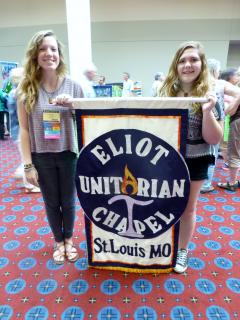Cultivating a Culture of Youth Leadership
Race to the Top for Unitarian Universalism
It’s a thrill every time I get a notification that a new youth has applied to our Luminary Leaders program. But I have to admit, the shock has worn off when I open the tab and see it’s another youth from Eliot Chapel in Kirkwood, MO and that it's Director of Religious Eduction Scott Stewart serving as one of the two required endorsements. Eliot Chapel has seven people (four youth Luminary Leaders and three young adult Luminary Alumni) in the program. Compare that to our second runner up, with 5 people in the program, four of whom were fast tracked into the program because they attended a national program sponsored by the Unitarian Universalist Association Office of Youth and Young Adult Ministries, and you can see it’s pretty impressive.
Does it mean that Eliot Chapel has more exceptional youth leaders than any other congregation in the nation? I don’t think so. But it does mean that Eliot Chapel has a staff team dedicated to creating a culture of youth leadership that includes recognition for their accomplishments and support along their leadership journey.
So what exactly does the staff team at Eliot Chapel do so that seven of their young people have been nationally recognized as exceptional lay leaders in our movement?
One of Scott’s philosophies is that Unitarian Universalist (UU) youth are some of your best congregation-wide ministry partners. He encourages youth to teach Religious Eduction, participate in meaningful ways in worship, and join congregation-wide committees and teams.
Scott spreads a message to the leadership teams within his congregation that young people should not be categorized simply as youth leaders, but that these are UU leaders with the capacity to make an impact on their congregation right now. In response to the old and familiar “youth as chair folders” cliché Scott says, “If you want youth involved in a project, engage them at the very beginning, otherwise they won’t be invested. Don’t invite them to do a predetermined task. Rather, validate what they’re capable of.” This kind of thinking shifts the culture from one where “We need some strong folks to move chairs” is replaced by “We want to work with some innovative folks who have new ideas.”
When young leaders are put in the position to succeed it provides a voice that the congregation is not used to hearing. For example, four youth at Eliot Chapel led a film night and co-facilitated a dialogue on racial justice with adults. And a lot of adults showed up! Eliot Chapel created space within existing structures for youth to explore their leadership, allowing them to create new and different ways for the whole congregation to explore racial justice, creating a space where youth and adults learned and grew together.
Scott embodies the culture of youth leadership by lifting up the accomplishments of young leaders, the opportunities that help them gain needed skills, and promoting the importance of the congregation recognizing youth as the important leaders they are.
Scott wants the congregation to take these young leaders seriously and knows that recognizing them as Luminary Leaders elevates their profile and inspires other youth to follow in their footsteps. It’s is a great way to recognize and reward youth who are already doing amazing things.
Ok, so the congregation is on board, but what’s the message he sends to youth that gets them to actually sit down and take the time to fill out the application to become a Luminary Leader? He tells youth that by applying they’re putting themselves in the best position possible to continue on their leadership journey, whether that’s increasing their access to financial aid, getting to network with other incredible leaders from across the nation or adding to their UU resume or college application. He tells youth to, “Take what you’ve already done and give yourself the best chance to continue and open future doors.”
But it doesn’t end there, even after youth have been accepted into the program, which requires completing an Application and obtaining two Endorsements from adult UUs in their life, Scott and the staff team at Eliot Chapel continue to celebrate and acknowledge the accomplishments of young leaders. Upon acceptance to the program, we in the Office of Youth and Young Adult Ministries send a letter of recognition addressed to the senior minister or board president. Then, lead minister Rev. Barbara Gadon posts those letters on a bulletin board for the whole congregation to see! Once youth have been recognized, Scott puts a flyer announcing their recognition on the youth group bulletin board and another congregational bulletin board. He promotes it on the Eliot Chapel Facebook page AND writes a newsletter article about it for the congregation wide email with links to learn more.
When I asked Scott how he possibly made the time to do all of this he said that it’s all about making it a priority. He focuses on the long-term benefits for supporting youth leadership development today. Young leaders elevate the energy of whatever project they’re part of. Parents LOVE having the youth teachers in religious education classrooms. And in the long run, it show parents that if their kids stay engage in church over an extended period of time, they will eventually become as great as the youth leaders.
So here’s a challenge for you: kick Eliot Chapel out of the number one spot for Luminary Leaders in the nation! Getting youth in your congregation into the Luminary Leaders program shows you recognize young people for their valuable impact on your community. Continue conversations with your leadership teams about ways to inspire, encourage, support and recognize the contributions of young people in your congregation. Send your youth to UUA.org/luminary and offer to endorse them for their contributions to sustaining and growing our faith!

